So you’re planning a high overnight camp and you’re wondering how warm your winter sleeping bag should be?
Likely Ambient Temperature
With a number of recent TV documentaries ‘laying it on a bit thick’ about how low the temperature can drop in Scotland’s Cairngorm Mountains you might be forgiven for thinking you were heading for somewhere akin to the high Arctic! Indeed the temperature in the Scottish Highlands has been recorded approaching -30 deg C (-27.2 to be precise – the official British record) but this has only been on three occasions in 120 years!
Interestingly, Cairngorm summit (1245m) has only ever managed a record minimum of around half of this at – 16.5 deg C (12th Jan 1987) whilst the residents of nearby Nethybridge (210m) at the foot of the mountain claimed the mercury dropped to -31.3 deg C on 10thJanuary 1982, the same night as one of the -27.2’s was recorded. Satellite evidence suggests they were right!
The vital bit of missing information on these – 30ish lows are that they’ve all been recorded as a result of temperature inversions. That is, cold air has flowed off the mountains and pooled in the valley bottoms where it’s cooled further whilst the mountain summits have remained appreciably warmer. These record minima are in no way a reflection of the likely temperature you would find on our mountains, possibly not surprising considering all our mountains are never that far from a relatively warm sea.
So what would be the likely temperature at the main snow-hole sites, let’s say, in the Cairngorms at around 1100m? Well, the seasonal minimum for 900m is usually around -8 deg C which could, at a pinch, translate to -10 deg C at 1100m but far more often in winter it’s around minus 5 and above. The point is, on our mountains we don’t experience anything like the temperatures you might get in e.g.Norway.
Be guided by advice of sales staff in the shop who should have some relevant experience. Ask for shop expert if your sales person doesn’t demonstrate sufficient knowledge of the range on sale.
Most importatly – buy quality for a sleeping mat. In winter, it is most important to make sure you are insulated from the snow beneath you as you’ll lose the majority of your bodyheat this way.
It goes without saying of course you need to be checking the weather forecasts before you head out. A tented high camp in winter needs to be carefully judged. Those who have got it wrong have ended up having their tent destroyed and gear being scatted far and wide by hurricane force winds.
Andy Bateman 14/11/14
USEFUL LINKS
Mountain Weather Information Service
Scottish Avalanche Information Service
A taster of winter skills, but the only way to really learn how to ice axe arrest is to do it yourself under the guidance of a winter mountain leader or other qualified instructor. Imagine taking a tablet or smartphone out in the snow to try and teach yourself … pretty much a lost cause at the end of the day and you’d be terrified of smashing your technology to pieces. Bit the bullet and book a course.
We found this video on YouTube, produced by the MCofS. Here Roger Wild introduces ice axe arrest and explains the basics which you’d learn on the hill with Andy (lead instructor with Scot Mountain Holidays). If you’re comtemplating a winter skills weekend, bear in mind that this is one of the core skills you’ll be learning, which many people have heard about before they book a skills weekend; however, as Roger Wild says: there’s a lot more to the full range of skills to keep you safe in winter and you should consider ice axe arrest to be the last in a series of skills aimed at preventing a sliding fall.
Check out our Top Ten Winter Skills tips: https://scotmountainholidays.com/blog/top-10-winter-skills-tips/
(A synopsis in pictures)
The snow’s back here in the Cairngorms and it’s only 4th November 2014 – plenty of time for the snow to build up for a fabulous Christmas and New Year in the Highlands. Take a look at our selection of winter images below – all taken in during winter seasons in the Cairngorms. Will it be an official white Christmas or just white on the high peaks of the Cairngorms
Photo caption: A day out in the snow – heading home in the sunset,
turning the snow pink and giving life to the Cairngorms –
also known as Mhonaidh Ruaidh (the red hills).
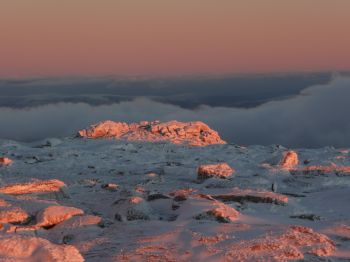
Photo caption: Sometimes a wee bit of cloud can play into your hands
and produce a much more stunning picture than a clear blue sky,
especially in the soft winter light we get here in the Cairngorms,
which is of course enhanced by reflection on the snow.
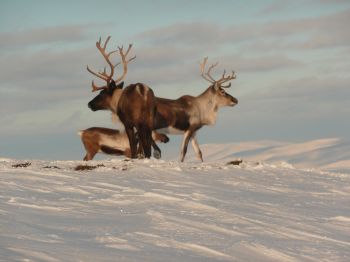
Photo caption: Unique to the Cairngorms National Park,
Britain’s only reindeer herd, which are free-roaming
across the hills in the winter. You could bump into them
on any of our courses or winter walking holidays.
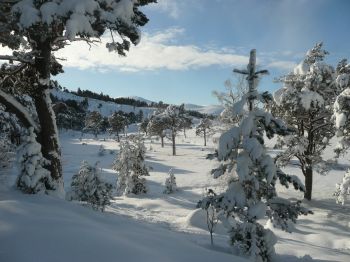
Photo caption: White Christmas? Wouldn’t that be amazing?
This is the kind of snow laden scene
we’d all like to see, but how many of you would like to
experience it yourselves? When the snow lay round about,
deep and crisp and even …

Photo caption: It’s New Year and it’s Scotland – must mean it’s time for a party –
or as you’re in Scotland let’s give it the proper name and join the ceilidh!
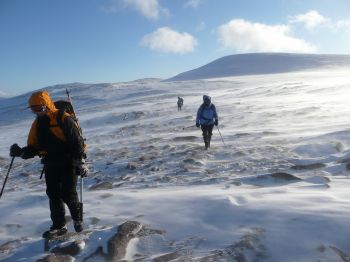
Photo caption: Winter walking holiday across the Cairngorm plateau. Check out the blue skies!
Inspired? Check out some of our winter offerings in the Cairngorms and further afield across the Highlands of Scotland
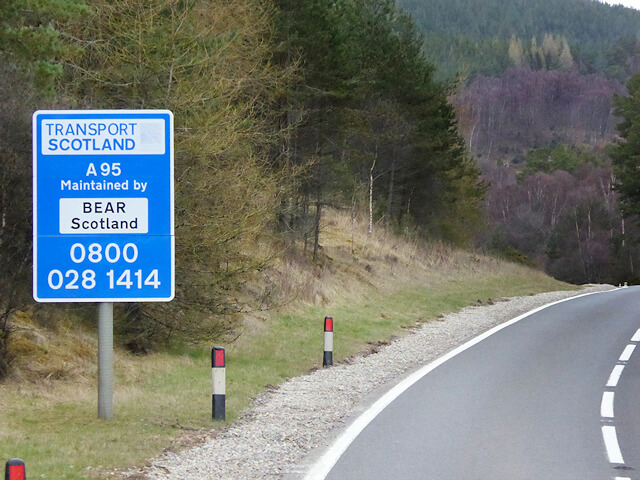
Road sign near Aviemore
You might be forgiven for wondering if there are bears in Scotland, if you see the signs by the side of the road. Why are bears constantly mentioned on the road signs? Sometimes even accompanied by a picture of a bear.
A family touring Scotland were getting increasing bemused and concerned by the signs they were seeing at the side of the road mentioning bears and Scotland on the same notice. What’s this they thought? Are there bears in Scotland? Eventually they asked the owner of the accommodation where they were staying … what’s this we’re seeing about bears in Scotland? Should we be worried?
The owner of the accommodation explained that the signs were about a company which maintains the trunk roads in Scotland called “Bear Scotland”. No cause for concern unless you spot a particularly rough section of road which needs resurfacing! Bear Scotland are also responsible for gritting the main roads in the winter.
Of course you can still see bears in Scotland but only in captivity. The polar bears at the Highland Wildlife Park and the Pandas at Edinburgh Zoo are a big draw for visitors.
The polar bears at the Highland Wildlife park are even more of a draw now than they used to be due to the birth of wee Hamish. Hamish is the first polar bear born in the UK for 20 years or so. You’d be forgiven even more these days for thinking bears are roaming around in Scotland as since Hamish’s birth there have been signs indicating where you can go to see polar bears!
Photo Caption: Polar Bear at the Highland Wildlife Park
Photo Credit: Scot Mountain Holidays
Join Scot Mountain Holidays for tailor made trips in the Highlands of Scotland including:
Guided walking holidays in the Cairngorms National Park are our speciality. The one which was most popular in 2014 was Complete Cairngorms. It has attracted bookings from France, Germany, Norway, Denmark, Russia … and only goes to show that the National Park designation has its own attraction. Guests from all over the world are choosing to spend their hard earned vacation on a visit to the Cairngorms.

Photo Caption: Exploring the Cairngorms on foot
Photo Credit: Scot Mountain Holidays
This trip is a fully guided hiking vacation in Britain’s largest national park. National Park designation has attracted a lot more visitors over the past 10 years than previously when though the British were, to some degree, award of the Cairngorm mountain range and the Cairngorm Ski Centre; even they had no idea of the extent and breadth of the Park itself.
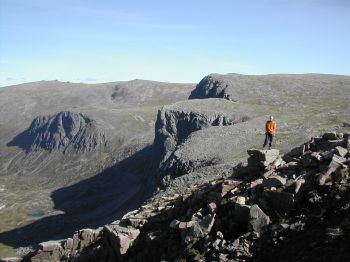
Photo Caption: Loch A’an – hidden deep in the Cairngorms this is a viewpoint you can only reach on foot.
Photo Credit: Scot Mountain Holidays
The Complete Cairngorms holiday takes place over a full week, but does have a rest day in the middle for clients to put up their weary feet or explore for a bit of retail therapy or souvenir shopping – if you’re lucky the trip might coincide with the summer sales in one of Aviemore’s multitude of hiking gear shops.
Essentially this is a hiking vacation with some culture, folklore and wildlife to enhance the hiking experience. A visit to the Cairngorms National Park would not be complete unless it took in the whole of the park. On this trip guests visit Glenlivet for the whisky and smuggler experience; Royal Deeside to walk on the Balmoral Estate (if the timing is right we may also visit the castle, though in August we may need to go to Braemar Castle instead – home of the largest Cairngorm Stone discovered) August is the Queen’s annual vacation which she spends at Balmoral Castle, so the castle is not open then; and of course we visit Cairngorm mountain itself and the surrounding estates of Glenfeshie & Rothiemurchus, with its wildlife hide, where we hope to see the elusive pine martens.
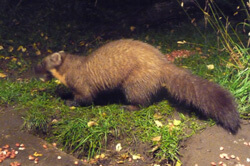
One of the rate nocturnal pine martens viewed from the Wildlife hide used by BBC Spring Watch programme
Photo caption: Pine Marten at the Speyside Wildlife hide in the Cairngorms
Photo credit: Scot Mountain Holidays
This holiday has attracted visitors from: Germany, France, the Netherlands, Denmark, Russia, and Finland which only goes to show how much the National Park designation attracts visitors in its own right.
Further guided walking holidays
Information about Royal Deeside: http://visitroyaldeeside.com/
Official Cairngorms National Park website: http://cairngorms.co.uk/
Visit Cairngorms website: http://visitcairngorms.com
Crampon compatibility is by no means the only criteria on which to determine whether a mountain boot is suitable for a Britain’s winter mountains. With 15 winter seasons of Winter Skills instruction and guiding under his belt, Andy Bateman of Scot Mountain Holidays takes us through various features of a good winter mountain boot.
The snow conditions on Scotland’s winter mountains are as varied as the weather that creates them. They are invariably more varied than any lying summer snow and combined with the variety of situations you might come across snow and ice, you don’t want to be limiting the techniques at your disposal before you’ve even set foot on the mountain. So it’s important to choose the correct winter boot.
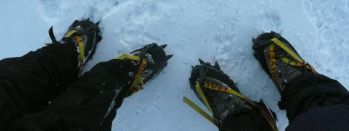
1. Sole Rigidity:
Winter days can be short so it’s important you move efficiently. If there is the opportunity to save time safely it’s wise to do so. Adding crampons considerably increases the weight of the boot and it has been calculated that a kilogram on the foot is equivalent to five in the sac in terms of energy expended. You certainly don’t want to be without your crampons but just simply bunging a pair of crampons on isn’t necessarily a fix all.
Sole Rigidity is in fact provided by the mid-sole and not the sole. It’s important that it’s across it’s width as well as down its length. With most modern boots if they have it one way they will have it the other. The key aspect of a stiff winter boot is it allows you to concentrate your body weight where the sole makes contact meaning either it cuts into the snow ice surface effectively (i.e. when using the edges) or the rubber keys into the snow/ice surface properly.
B2/B3 boots have better grip on the snow and ice than do B1 boots meaning you can possibly reduce the time you wear your crampons. Walking on thinly snow covered rocks in crampons can be awkward so often it’s a stiff boot that’s the most effective way to deal with this situation.
Depending on the situation it may be far quicker to just to kick a few steps than stopping to put crampons on. In firm snow conditions B1 boots can often be too flexible to do this properly. For instance the when kicking pidgeon hole steps the toe will often bend up and “bounce off” without the sole cutting into the snow. The same can be the case when kicking other types of steps. It can also be rather uncomfortable for the feet.
B1 boots are usually too flexible resulting in the toe bending up and the heal dropping down. This leads to the front 2 points shearing out of the snow/ice surface and the possibility of you falling backwards out of the step.
Crampons are tough bits of equipment but they aren’t indestructible and they should be supported by a rigid sole. Fitting a crampon to a flexible boot can greatly increase the stress on the crampon which over time can lead to it breaking. Again it can be uncomfortable on the feet.
3. Robust upper
With more flexible boots, the upper can tend to be too soft. This can result in the feet feeling restricted when the crampons straps are pulled tight, the danger being restricted blood circulation and associated cold feet, or worse a cold injury like frost bite.
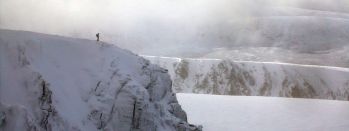
4. Better insulation
A good winter boot is also better insulated and hence reducing the chances of cold feet or worse. Often the additional insulation so provides added padding and hence comfort.
Conclusion
Your boot is as much a tool as your axe or your crampons and for a winter walking trip a B3 boot isn’t overkill. A B1 boot may be adequate for a challenging summer trek involving a glacier crossing in theAlpsorHimalayasbut isn’t really enough for theScottishMountainsin winter.
If you are about to head out to your local gear shop to try on some boots I would check first which of the staff have been properly trained in boot fitting and that they are going to be there when you turn up.
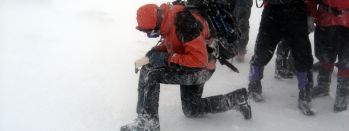
Ask what you might need in advance; don’t be worried if you’re not an experienced mountaineer as there will still be lots available to do; go for it!
Most Scots don’t question the origins of Hogmanay, just as you wouldn’t question the traditions associated with any of your big national celebrations such as Thanksgiving, or Christmas, or Easter. I’m sure a lot of kids in the local schools would be hard pushed to tell you why Hogmanay is such a big deal; so much so that all Scots have an extra bank holiday at the beginning of the year that the English don’t get.
Hogmanay – as a word – is said to have either French or Norse roots. There is some confusion and argument as to which of these influences has the strongest claim to being the root of the word. The French word means the act of giving a gift to bring in the New Year or the children’s tradition of asking for sweets or small treats to bring in the New Year – a bit like trick or treating at Halloween.
Many of the traditions though are associated with ancient fesivals like the Gaelic “Samhain” (which also has close ties to Halloween as it marks the end of the harvest and the beginning of winter) and the winter solstice.
Of course any cause for celebration here in the Western Hemisphere and we break out the alcohol and dance!
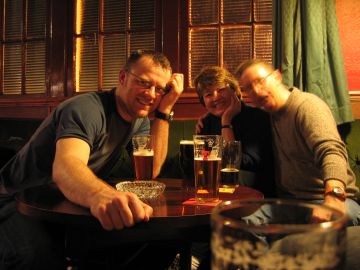
When Protestantism under John Knox was gaining support in Scotland, it was turbulent times across the whole of Britain. Catholicism was under attack and the festivities of Christmas were seen by Knox as a very Catholic tradition and as such despised. He moved to abolish the celebration of Christmas in Scotland as being too Catholic by far.
Of course this did not mean that the celebration went away completely, it was just transferred somewhat over to New Year. After all, everyone needs a reason to celebrate something in the depths of winter.
There are many traditions related to Christmas in England and the rest of the continent that are only visited once a year at Christmas time. Many wonder why – for example, why are brussel sprouts so strongly associated with Christmas? Watch this hilarious video from Michael Mcintyre about his interpretation of Christmas traditions.
Nowadays we have reason to thank John Knox as his ban has meant that in Scotland we get an additional public holiday to bring in the New Year and the differing traditions associated with Hogmanay bring many a visitor to Scotland:
In Edinburgh they have one of the biggest street parties in the world with an amazing firework celebration which has been in the Guiness Book of Records.
In Stonehaven, there is a fireball parade.
Across the country people visit each other from midnight onwards to “first foot”. It brings good luck for the year for a visitor to be asked in on New Year’s Day. You should take a piece of coal, whisky and black bun i.e. food, drink and warmth/comfort.
Here at Fraoch Lodge we head out into the snow and bring the New Year in with a walk across the high peaks of the Cairngorms using all the cramponing and ice axe techniques learnt during our guests stay leading up to New Year’s Day.
Funny though – when you look through the other images on Flickr no one else seems to think about New Year celebrations in quite the same way!
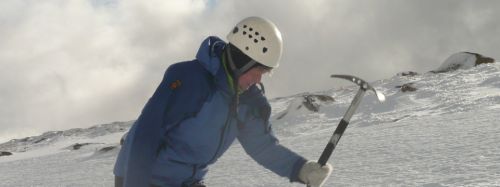
Reference:
The Great British Bake Off explains Hogmanay food
en.wikipedia.org/wiki/Hogmanay
The advantage of the Cairngorms with kids in tow is that the walking opportunities are almost endless at all levels depending on your child’s level of interest and energy. Almost every village in the Park has had a network of paths put in with the support of the National Park to give both locals and vistors extensive opportunties to explore through the woods, across the moorland, around the lochs etc. And if you want to do a wee bit more of an adventure you could try one of the Treasure Trails or try the permanent orienteering course at Glenmore.
There’s as wide a range of walks to do with the kids as you have time for here in the Cairngorms and the majority of the walks are circular so you don’t have to retrace your footprints. Walks vary in length but the majority are aimed at being no more than a half day’s activity so you could also do something else with the rest of the day – visit a castle, see Dolphins, go to Landmark Forest Adventure Park, go for a wild swim or a swim/slide in the swimming pool, try another activity, visit the polar bears and tigers at the Wildlife Park ….. The plethora of opportunities mean that we have trouble understanding why anyone would only want to spend one night with us; but perhaps not everyone is into the scenery and the outdoors.
Treasure Trails have produced a series of mystery/adventure stories where you solve the clues/puzzles along your walking route. The trails are available all over the UK, even in the Cairngorms National Park. We have a stock of the local trails here at Fraoch Lodge so if you want to spice up a local walk instead of just admiring the scenery and seeing what nature you can spot (giant anthills, ripe bilberries, raspberries, mushrooms, red squirrels etc) you can try one of these trails or purchase your own from http://www.treasuretrails.co.uk/scotland-northeast/things-to-do.html There are trails available in Aviemore, Kingussie, Newtonmore, Forres & Grantown on Spey among others – all of which are easily accessible from our base in Boat of Garten.
Loch an Eilean – voted Britain’s most popular picnic spot. The Loch is a very attractive spot with a ruined castle on it. The path around the loch is a forest path. There are rocks and tree roots along the way but then that’s nature. The root is not really suitable for push chairs but can be managed by relatively young children. Full details are available on the link provided.
Craigellachie Nature Reserve – a lovely wee walk for all the family which passes a wee lochan and can be extended up the hill if the enthusiasm is there.
Loch Garten and Loch Mallachie – Just a wee stretch of the legs, but in season the break can be extended to include either a loop through the forest or visit to the RSPB visitor centre (open Apr – Aug) to see the Ospreys.
Farleitter Crag and Uath Lochans – This route must be access by car as there is no public transport down Glen Feshie.
There are several way marked routes in the woods behind Fraoch Lodge and they are all marked out. You can even see the Capercaillie statue made from wood with the help of the pupils at the school. We also have a woodland ranger who leads walks and produces a blog for the village (on the website). The walks have a minimal charge associated with them but are extremely informative. Examples of the routes are: The Salmon trail – or the Red Squirrel trail.
Further details:
Walks around Boat of Garten woods – no transport required as these can all be accessed from our front door
Information about the Boat of Garten area
The Speyside Way (sections)
1. Boat of Garten to Aviemore – This is a lovely section of the Speyside Way which if done from Boat to Aviemore means you’re facing the Cairngorm Mountains the whole way and if you’re lucky the steam train will puff past you as you walk. The route comes into Aviemore past the Spey Valley Golf Course and Cairngorm Brewery before getting close to the centre of Aviemore.
2. Boat of Garten to Nethybridge (or extend to Grantown on Spey) – the main problem with extending the walk through to Grantown on Spey is the number of gates you have to go through along the way – but you never know that could turn it into more of an adventure for the kids. There are also several fixed information points through Balliefurth Farm explaining a little more about the countryside and the bonus is that you’ll come down to Grantown past Spey Valley Smokehouse where you can view the workers producing packs of smoked salmon to be distributed across the country.
Anagach Woods in Grantown on Spey – http://www.walkhighlands.co.uk/cairngorms/anagach-woods.shtml
Glenmore to Aviemore – can be accessed by bus. Ask for details while staying at Fraoch Lodge.
Ord Ban – http://www.walkhighlands.co.uk/sub2000/ord-ban
Carn Eilrig – see Andy for route description and full details. May be for older kids or for a bike/hike combination.
Meall a’Bhucaille – http://www.walkhighlands.co.uk/cairngorms/meallabhuachaille.shtml
Cairngorm – from the ski car park to the summit. Children from age 5 or 6 can probably manage this walk on a fine day. The bonus is that they or all of you can summit your/their first munro without actually climbing up 3000ft.
This is by no means a comprehensive list. A great many other options are available. Andy will be very happy to discuss with you as many options as you wish when you come to stay. He’ll then be able to tailor all his suggestions to your experience, ambitions and weather.
For some other options which you may like to read about before you visit, you could always try the Walk Highlands website. We have worked closely with Helen and Paul Webster who run the site. They too are experts on the walking opportunties in this area as they live in Grantown on Spey.
Stunning remote wilderness scenery
Scot Mountain Holidays put a new trip together this year (2013): an exploration of Harris and Lewis. As usual, this was very well planned and the logistics carefully thought out. We departed their base at Boat of Garten, picking up clients at Aviemore and Inverness stations, before driving to Ullapool. There we boarded the ferry to Stornaway, for which we arrived in plenty of time. On the crossing, there was time to admire the receding scenery of the northern mainland mountains and the approaching islands silhouetted against the setting sun, as well as to enjoy a meal on board. From Stornaway we then took an interesting drive down to Tarbert, our base for the week in some well-equipped holiday cottages.
Andy had prepared a very varied itinerary, a pleasant blend of hill and coastal walking, with visits to many places of interest. As always, he was a mine of information on the geology, the geography, the flora and fauna and especially the bird life. Among other species, we saw lapwings, golden plover, cormorants, gannets fishing, a Great Northern Diver and, of course, at least half a dozen eagles ….
Beautiful white sand beaches of the Hebrides
On the midweek ‘rest’ day, we had the opportunity for a scenic drive around south Harris. We visited a prehistoric standing stone and also a visitor centre. I was intrigued to discover why Lewis and Harris have separate names, even though they are one landmass. In former times, there were no roads through the hills forming a barrier between the two, so all the traffic had to be by boat around the coast, effectively making them separate islands!
We also discovered that the island has become something of a haven for artists and photographers. There are quite a few studios dotted around, often with hospitable cafes! For the botanist, the coastal scenery is much enhanced by the ‘machair’ wild flower meadows.
There is much of interest too for the historian: the famous prehistoric standing stones at Callanish, an Iron Age ‘broch’ (chieftain’s house) in a well preserved state, and more recently the ruins, mainly just a chimney, of a former whaling station; there is even a present-day indication of long-established customs in that many people still cut and dry peat for fuel!
I have so far not mentioned the hillwalking, which can be very challenging even though the hills are not of the highest, due to the dearth of paths and tracks, giving one a real feeling of pioneering. And:
“These mountains don’t know they’re 2000 feet high, from the rock
Of the summit, where the clouds cling, down to the lap of the loch.
In their mist shawls they crouch, silent, by the side of the glen,
Indifferent to Man and the measures of men.”
Even dedicated ‘Munro-baggers’ would find much to enjoy here, since the terrain is very rugged, the ascents are often steep and one usually starts from sea level. Coupled with the remoteness of the island, this means that we encountered few other walkers during the week.
Probably my favourite ascent was that of Tiorga Mor. After an interesting walk up the valley track, we turned on to the mountain shoulder. This gave some superb walking up ‘boiler-plate’ slabs, with occasional delectable little scrambles, to the summit ridge.
From the top, we had extensive views over many islands, including Taransay (of TV’s ‘Castaway’ fame) and even St Kilda on the far horizon. Looking down on the white sand beaches and the turquoise sea-shallows it made me think of Greece, another country which I love. From the summit, we turned north to traverse Tiorga Beag and eventually started to get increasingly dramatic profile views of the north end of Sron Uladale; this is of particular interest to those of a rock-climbing bent, as it is the largest crag overhang in Britain. Some brave soul has even jumped off the top with a parachute!
Complementing Andy’s expert and informative guiding was the magnificent cuisine produced by Rebecca. After a substantial breakfast, we had a wide choice of fillings for our sandwiches. We assembled our own lunches with the fresh home-baked bread. On our return to base, we enjoyed the famous ‘Cake-o-Clock’: refreshing tea and home-made cake, before the excellent evening meals.
Apart from the main scenic delights, there were other intriguing little sights for those of a whimsical turn of mind:
a well-maintained tennis court miles down a single-track dead-end road, probably the most remote such facility in Britain, if not the world; and an optimistic ‘For Sale’ sign in front of a derelict cottage
On the return ferry there was of course sadness at leaving this unique place, but also compensation in the approaching views of the northern Scottish mountains across a sun-smeared sea.
Overall, this was a very interesting and enjoyable trip, underlining the Scot Mountain Holidays slogan: “A Sense of Place and Belonging” It is an expedition well worth repeating.
Mick Wansborough June 2013
All content © Copyright Scot Mountain Holidays 2024
Responsive web design by Summit Web Solutions